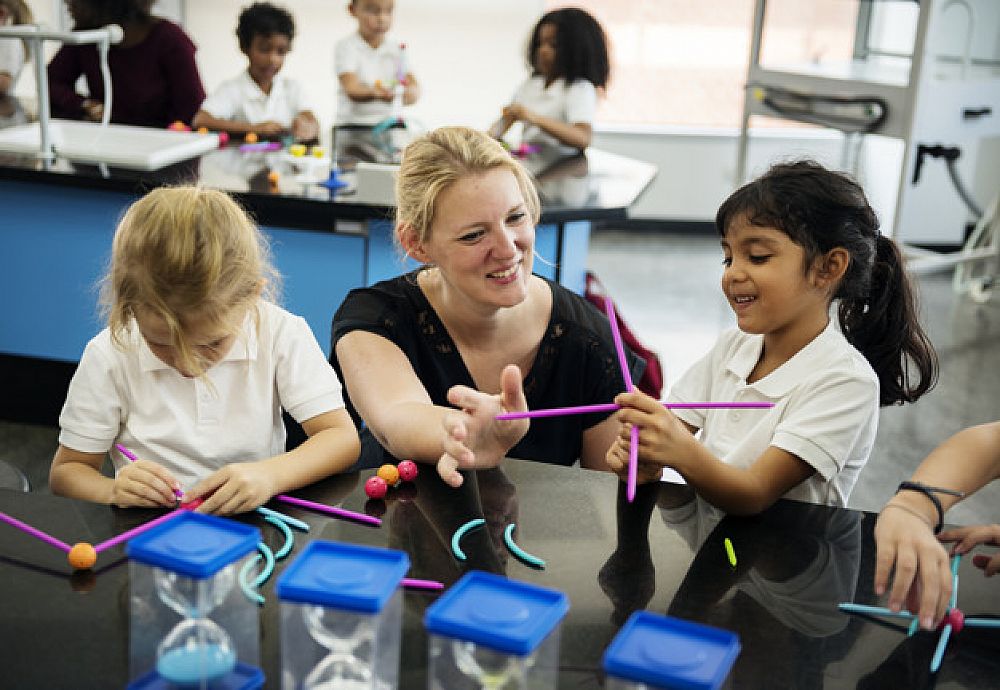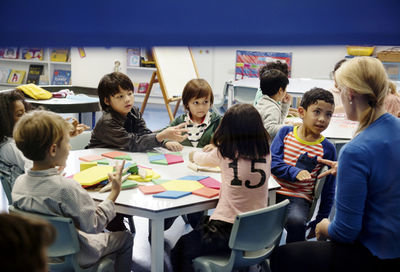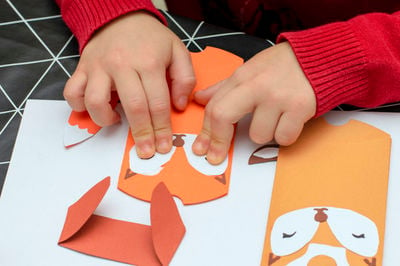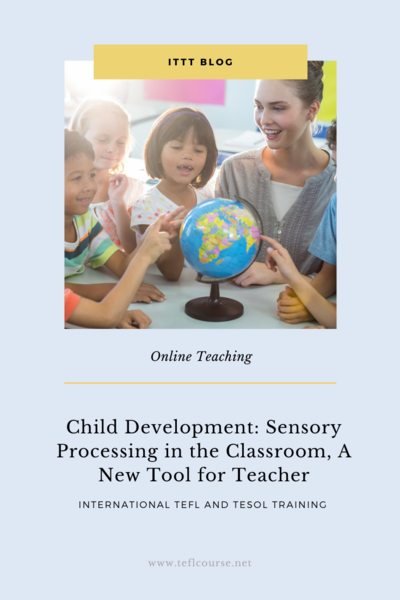Child Development: Sensory Processing in the Classroom, A New Tool for Teachers

Child Development is a complex topic and can be described with a myriad of approaches formulated by scientists, psychologists, therapists and teachers alike. These approaches can break this topic down for those of us who work with children so that we may have a framework for what we are observing.
Table of Contents
New Approach to Child Development
Child Sensory Development Model
What Makes Successful Students?
Do you want to teach English abroad? Take a TEFL course!
This post was written by our TEFL certification graduate Karen A. Please note that this blog post might not necessarily represent the beliefs or opinions of ITTT.
Theory Implementation
Theories can also be used to help explain to us the various factors that impact a child so we can feel empowered to understand or help. Methods give us the tools to do so. Sometimes, we use theories or methods for career preparation, to give us a basic comprehension of what we will be working with as we engage with children. Sometimes, we use them further down the road to help us problem-solve when we are actively working with children as we see issues arise. Even academic standards and metrics can act as a guide as they can help us define 'normal', allowing us to monitor and possibly assess problems from early on. For those that teach children, this can be a complex path to walk on. Defining what 'normal' is for children in a learning environment embraces so many different dynamics, and touches on so many approaches, that it can overwhelm a teacher if they were to stop and think about all that could be considered.

Also Read: What does TEFL mean?
New Approach to Child Development
One important approach to understanding child development, and what children need to support their learning, is the need for appropriate sensory processing. This is a new area of research stemming from Occupational Therapy, and there is an increase in awareness of this subject and its importance among teachers in the United States. The new popular thought of 'sensory needs' in children being accommodated for, or allowed in the classroom, is often looked upon with some criticism. It's understandable as to why as it's like pinning down a cloud. For a teacher, this can be a confusing topic altogether and can be applied to just about every child. How does this new topic appropriately fit into the classroom, and how should a teacher understand it so that they don't get caught up in sensory toys and activities and can't accomplish the actual lesson they are there for? I find this question important as it can seem like one more thing to consider in an already packed syllabus for the year, and it may be difficult to manage lesson plans to accommodate it. So, knowing that sensory processing closely pertains to child development, and supporting best learning, there needs to be a way it can be easily understood.
Also Read: Teaching English in France - The Salary and Budget Guide
When most people think about sensory processing, they consider the five senses and leave it at that. The follow-up question should be, "How do taste and smell affect a child's learning?". Too often we overstress the importance of seeing and hearing in classroom activities without taking into consideration the child's sensory system more comprehensively. The thing to remember is that our senses are more complex than that. Helping teachers see all the senses, and how they support better learning will be difficult unless they can see it from a 'bird's eye' view. Formerly, in my practice as an Occupational Therapist, we used a pyramid diagram. Once the pyramid is understood, one can see that any holes in the pyramid could cause the entire structure to collapse. It can help them identify possible areas of need if a child is struggling in learning.

This model in child sensory development is one of many users with Occupational Therapists but appeared to be one of the most helpful for parents and teachers when I used it to help them understand what was happening if a school-aged child happened to have a deficit in their sensory processing. It didn't solve all the problems, but it certainly helped people to feel like there was a partial answer to the learning issues they were observing or at least another piece of the puzzle was found. With some help from ancillary services, a teacher didn't have to feel overwhelmed with personal responsibility. It was the therapy that helped to fill those holes in the pyramid so that it could be a more solid structure, which made learning easier, teachers relieved, and parents happier.
Also Read: From Immigrant to ESL Teacher - A TEFL Graduate's English Teaching Journey
Child Sensory Development Model
First, we will start at the bottom with the label of "Sensory System Abilities". These essentials within that space include Olfactory (smelling); Visual (seeing); Auditory (hearing); Gustatory (tasting); Tactile (physical feeling ability); Vestibular (balance ability); and Proprioception (knowledge of your body in physical space ability). These skills not only tell a child what is in their environment but gives them a sense of security as their body can remain calm and stable. They also help the child understand when there is a need to change when discomfort arises in any of those areas, which is a sensation warning them of possible danger. They also support the next level of developmental skills a child needs to learn for sitting at a desk, handling a pencil properly, passing out papers, staying in line, putting on their coat and opening their backpack.
These skills are labeled "Sensory Motor Development Abilities", on the next level upon the pyramid. The essential skills to write in this block are as follows: Body Scheme (knowing the 'where' of one's body parts); Reflex Maturity (having developmental reflexes for survival integrated into your motor plan without taking over your motor plan); Ability to Screen (sorting physical input you receive into your nervous system and properly categorizing them as 'alerting' or 'calming'); Postural Security (knowing up and down and having the adequate strength to keep one's body upright); Bilateral Awareness (knowing right from left and knowing that you can cross over each area with the opposite side); and basic Motor Planning (knowing what an action takes for your body to perform it successfully). Having a good grasp on motor skills helps a child in the classroom for successful learning, but these skills can be overlooked as they are so minuscule. As small as they are, we can see that they are foundational for the parts of learning related to motor functions needed to support the learning demands. They also support the next level up, which is the most difficult skill of them all to identify any dysfunction in without a trained eye or lots of observation.

These skills are labeled "Perceptual Motor Development Abilities". These skills help children to appropriately read letters or numbers in order or scan for papers on their desk. They also assist children with maintaining a prolonged gaze towards the board or the teacher. For essay writing or even filling in a gap-fill exercise, these skills are necessary to achieve the task successfully. If these are holes below this level, it will certainly show up in these higher functions. The skills to write down in this block are: Eye-Hand Coordination; Ocular Motor Control (how well your eyes team together); Postural Adjustment (the ability to correct your posture based on head position); Attention; Visual-Spatial Perception (the brain's ability to understand what is being seen in relationship to other visual stimuli); and Auditory Language Skills (ability to listen properly and formulate language from it). It is easy to see with the complexity of these skills how teachers may see a child, 'fall apart' with having to appropriately function in this skill set when they don't have the supporting skills strong enough to execute these functions with ease.
Also Read: "Common Speaking Challenges in China"
Finally the top of the pyramid, where we have only the highest of expectations for functional capacity. We as adults value these skills labeled as "Cognitive Intellect and Ability" so much that we often focus on this more than the others. It's understandable as to why, as these skills are easily identified, easily measured and are the pinnacle of healthy function. Skills that we expect children to master over time are as follows: Daily Living Activities (dressing, grooming, etc.) and Behavior. These skills support the very top of the block which is the skill of Academic Learning. It may seem obvious why these skills are at the top and are classified as 'cognitive' in their nature. But as you step back and look at the pyramid you have just made, maybe you can now see why holes at the bottom or even the middle can make that top block a bit shaky, or even cause it to collapse entirely.
Sometimes the poor student is just trying to 'hold it all together' on a regular class day, and we don't realize this is what is causing the issues that we see in their academic learning. I think many teachers can identify 'the child' they have had, or currently have in their class that doesn't maintain attention, or the child that leans so close to their desk work it's hard to fathom what they see... and they seem 'too focused'. How frustrating that can be when there is a problem, but it can't be figured out 'why' they are doing what they are doing! It is a child's attempt at compensation or coping (or sometimes a lack thereof) for a bigger issue below on the pyramid, and that skill you ask them to perform is on a shaky foundation. Most often, these kids may have some sensory deficits and are trying their hardest. That is if it is their only issue (excluding co-morbid conditions).
Also Read: "What do You Need to Teach English in Europe?"
What Makes Successful Students?
Again, many factors contribute to success in learning for children. From the home environment and support the teacher's experience and tactics to the programs used that are age-appropriate; there are lots of things to consider. Child development is important for teachers to understand. It can help us as teachers to know what kinds of skills we can expect a child to have at certain milestones ages. In this, I hope that this diagram can be a tool for a teacher to understand a child's needs from a different angle if all other areas have been addressed and there is still a struggling student at the desk every day.
Do you want to teach English abroad? Take a TEFL course!
Maybe a referral to an Occupational Therapist or Speech Therapist can help with an underlying issue on the pyramid that a teacher may have no time or tools to assess with. With this in hand, the teacher can at least be clever enough to at least identify a possible crumbling block and talk to the parents about further assessment. Or, it can help a teacher understand the 'why' when a student arrives at the class with an order for accommodations provided by an ancillary service provider. Knowledge about child development is multifaceted and hard to fully grasp while teaching, but without it, our teaching would be ineffective and irrelevant. I hope that the pyramid diagram is another tool in the toolbox for teachers affected by this new trend in learning needs, and help them understand how we can support students well within that context.
Apply now & get certified to teach english abroad!
Speak with an ITTT advisor today to put together your personal plan for teaching English abroad.
Send us an email or call us toll-free at 1-800-490-0531 to speak with an ITTT advisor today.
Related Articles:
- 10 Tips to Help You Enjoy Your TEFL Course
- 7 Fun Activities for Teaching Vocabulary in the ESL Classroom
- Differences in Teaching Monolingual and Multilingual EFL Groups
- Why Taking a TEFL Course Is Highly Beneficial
- How To Write The Perfect ESL Lesson Plan
- 8 Amazing Things You Can Do with a TEFL Certificate




